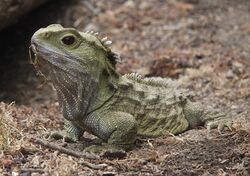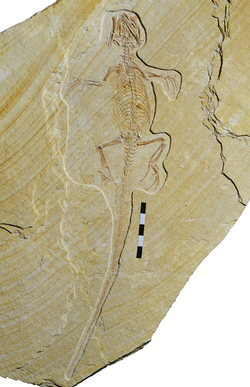Biology:Sphenodontidae
| Sphenodontidae | |
|---|---|

| |
| Tuatara (Sphenodon punctatus) | |

| |
| Skeleton of Sphenofontis, a sphenodontine from the Late Jurassic of Germany | |
| Scientific classification | |
| Domain: | Eukaryota |
| Kingdom: | Animalia |
| Phylum: | Chordata |
| Class: | Reptilia |
| Order: | Rhynchocephalia |
| Suborder: | Sphenodontia |
| Family: | Sphenodontidae Cope, 1870 (conserved name) |
| Type species | |
| Hatteria punctata Gray, 1842
| |
| Subgroups | |
| |
| Synonyms | |
| |
Sphenodontidae is a family within the reptile group Rhynchocephalia, comprising taxa most closely related to the living tuatara (Sphenodon punctatus). Historically the taxa included within Sphenodontidae have varied greatly between analyses, and the group has lacked a formal definition.[2] Cynosphenodon from the Jurassic of Mexico has consistently been recovered as a close relative of the tuatara in most analyses, with the clade containing the two and other very close relatives of the tuatara often called Sphenodontinae.[2] The herbivorous Eilenodontinae, otherwise considered part of Opisthodontia, is considered to be part of this family in many recent studies as the sister group to Sphenodontinae. The earliest Sphenodontines are known from the Early Jurassic of North America, with other remains known from the Late Jurassic of Europe, the Late Cretaceous of South America and the Miocene-recent of New Zealand. Sphenodontines are characterised by a complete lower temporal bar caused by the fusion of a forward directed process (extension) of the quadrate/quadratojugal and the jugal, which was an adaptation for reducing stress in the skull during hard biting. Other synapomorphies of Sphenodontinae include the presence of nasal foramina, a posterodorsal process of the coronoid of the lower jaw, the present of caniniform successional teeth at the front of the jaws, the presence of flanges on the posterior parts of teeth at back of the lower jaw, and an expanded radial condyle on the humerus.[3] Like modern tuatara, members of Sphenodontinae were likely generalists with a carnivorous/insectivorous diet.[4]
Cladogram after Simoes et al. 2022:[3]
| Sphenodontia |
| |||||||||||||||||||||||||||||||||||||||||||||||||||||||||||||||||||||||||||||||||||||||||||||||||||||||||||||||
References
- ↑ "A basal sphenodontian (Lepidosauria) from the Jurassic of Patagonia: new insights on the phylogeny and biogeography of Gondwanan rhynchocephalians". Zoological Journal of the Linnean Society 166 (2): 342–360. 2012. doi:10.1111/j.1096-3642.2012.00837.x. [R. Benson/R. Benson]
- ↑ 2.0 2.1 "Sphenodontian phylogeny and the impact of model choice in Bayesian morphological clock estimates of divergence times and evolutionary rates". BMC Biology 18 (1): 191. December 2020. doi:10.1186/s12915-020-00901-5. PMID 33287835.
- ↑ 3.0 3.1 Simões, Tiago R.; Kinney-Broderick, Grace; Pierce, Stephanie E. (2022-03-03). "An exceptionally preserved Sphenodon-like sphenodontian reveals deep time conservation of the tuatara skeleton and ontogeny" (in en). Communications Biology 5 (1): 195. doi:10.1038/s42003-022-03144-y. ISSN 2399-3642. PMID 35241764.
- ↑ Villa, Andrea; Montie, Roel; Röper, Martin; Rothgaenger, Monika; Rauhut, Oliver W. M. (2021-05-03). "Sphenofontis velserae gen. et sp. nov., a new rhynchocephalian from the Late Jurassic of Brunn (Solnhofen Archipelago, southern Germany)" (in en). PeerJ 9: e11363. doi:10.7717/peerj.11363. ISSN 2167-8359. PMID 33987027.
Wikidata ☰ Q3493224 entry
 |



